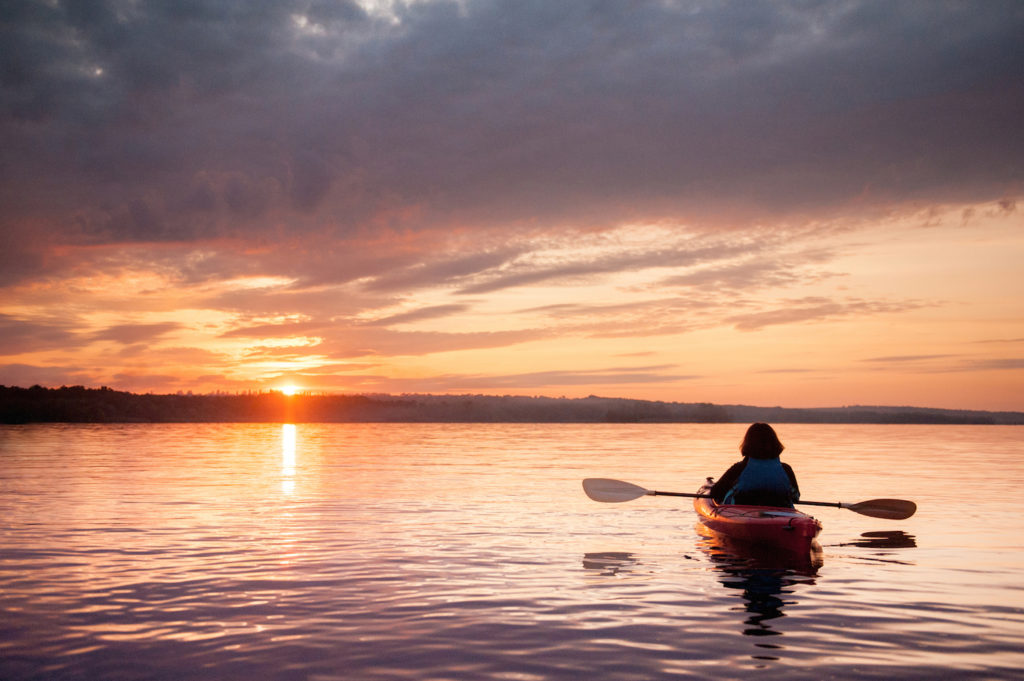
By Diane Morales
Kayaking is great fun, great exercise, and a delightful way to explore the surrounding shorelines to observe nature’s treats at close hand. At Queen’s Landing, we are blessed to have easy access to Macum Creek and the Chester River. In our wider community, there are plentiful other opportunities for kayaking adventures.
The Chesapeake Bay Environmental Center (CBEC), right here in Grasonville, rents kayaks and offers access to Marshy Creek, the Narrows, and Prospect Bay. You can also launch your own kayak there if you are a member.
This year they will be offering monthly guided kayak tours from May through October, as well as lessons in kayaking.
The lessons are a wonderful way for both beginners and intermediate level kayakers to assure they have the necessary kayaking skills and safety knowledge. If you do sign up for a course, you will learn valuable information regarding proper equipment and paddling methods, entering and exiting the water when launching from a dock, safety considerations and “rules of the road” on the water, rescue techniques, and even how to safely mount a kayak on a vehicle. The course material is provided by the American Canoe Association and is taught by ACE-certified instructors. (The name American Canoe Association is misleading, as they support all paddle sports.)
Kayak vendors may also provide instruction; and if you already are a skilled kayaker but would like to improve your knowledge, there is plenty of information available on-line.
Regardless of whether you are just interested in lazy paddles on quiet waters or whether you yearn for more challenging excursions, it is always important to take some basic safety precautions.
1. First, be sure to check water temperature before heading out. As spring approaches and we enjoy more frequent warm days, we may be tempted to get those kayaks out for some early outings. These can certainly be delightful, but don’t do so unless both water and air temperature are at least 60 degrees. Even if you do not plan to stray far from shore, remember that immersion in cold water can cause death by hypothermia in as little as 10 minutes. After all, capsizes do occur. Body temperature plummets quickly when immersed in cold water, and could quickly lead to hypothermia and death. Children and people of lower body weight are at even greater risk. Even if the weather is warmer, avoid wearing cotton clothing, which absorbs water, and opt instead for clothing designed to dry quickly. And by the way—to minimize the risk of capsize, remember to steer into a wave on a diagonal rather than take it broadside.
2. Also check the weather forecast. The day may look perfect, but weather can change suddenly and with little warning. You DO NOT want to be out in a thunderstorm, or in conditions of low visibility, high winds, high waves, or a sudden change in temperature. Always be prepared to exit the water quickly in case of a sudden change in weather.
3. Regardless the weather, be sure you head out properly equipped. Wear a properly-fitting life vest and bright clothing for visibility. Make sure you have a bilge pump, or at least some towels that can help to remove water that might enter the kayak. It is also a good idea to carry a whistle and a throw line. If there is any possibility you will be returning after sunset, be sure to have a light onboard. And don’t forget the hat, plenty of water, and sunscreen.
4. Don’t kayak alone, be prepared for emergencies, and make sure that others know your plans. Even if you are restricting your kayaking to calm waters, it is always a good idea to be prepared for the unexpected.
5. Beware of other boats. Never try to cross in front of a motor boat, and remember that larger boats may not even see you. This is especially true in foggy conditions or when visibility is otherwise low. Sunset can also be a dangerous time, since the setting sun can obscure the visual field of a larger boat. In short, stay clear of other boats and assume that they do not see you. In particular, stay clear of boating channels, or if you must cross them, do so with utmost caution.
This, of course, is not an exhaustive list. The information in this article was gleaned primarily from notes I took a couple of years ago as a participant in one of the CBEC kayaking courses, and from various internet sites (referenced below). If you would like to take a course yourself, check out the first link below, or explore some of the other links to kayaking opportunities in Maryland and more information on safe kayaking.
Instruction and courses:
Safety Tips:
Hypothermia:
Places to kayak in Maryland:
HAPPY KAYAKING!


